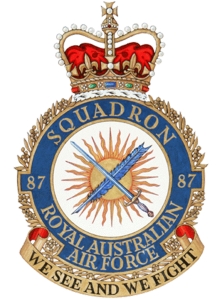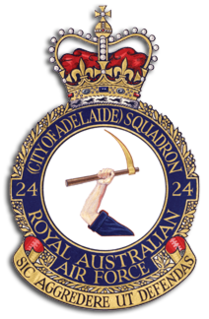Related Research Articles

The Australian Defence Force (ADF) is the military organisation responsible for the defence of Australia and its national interests. It consists of the Royal Australian Navy (RAN), Australian Army, Royal Australian Air Force (RAAF) and several "tri-service" units. The ADF has a strength of just over 85,000 full-time personnel and active reservists and is supported by the Department of Defence and several other civilian agencies.
The Airfield Defence Guard (ADG) mustering of the Royal Australian Air Force (RAAF) performs specialist ground defence tasks to protect air power assets from hostile ground action. The mustering is composed of non-commissioned members, commonly called 'ADGies,' most of whom are employed within a Security Forces (SECFOR) Squadron (SQN). Their primary role is the protection of RAAF equipment, personnel, assets and facilities during operations. While ADGs train to counter special forces as the primary ground threat to the projection of air power, ADGs are themselves conventional forces. Other duties include training RAAF personnel in weapon handling and basic ground defence tactics.

No. 28 Squadron was a Royal Australian Air Force (RAAF) Active Reserve squadron, based at HMAS Harman in the Australian Capital Territory. Its main role is public affairs and imagery. The squadron was formed in 1983 and disbanded in 2020.

RAAF Base Richmond is a Royal Australian Air Force (RAAF) military air base located within the City of Hawkesbury, approximately 50 kilometres (31 mi) North-West of the Sydney Central Business District in New South Wales, Australia. Situated between the towns of Windsor and Richmond, the base is the oldest base in New South Wales and the second oldest in Australia. The base is home to the transport headquarters RAAF Air Lift Group, and its major operational formations, Nos. 84 and 86 Wings. The main aircraft type operated at the base is the Lockheed C-130 Hercules. Richmond is a regular venue for air shows and had at times been mooted as a site for Sydney's proposed second international airport.

The Royal Australian Air Force's No 1 Combat Communications Squadron (1CCS), is a Squadron within 95 Wing and is responsible for the provision of expeditionary Communications and Information Systems (CIS) to support Air Force and Australian Defence Force operations and exercises.
The Royal Australian Air Force (RAAF) traces its history back to the Imperial Conference held in London in 1911, where it was decided aviation should be developed within the Armed Forces of the British Empire. Australia implemented this decision, the only country to do so, by approving the establishment of the Central Flying School (CFS) in 1912. The location for the proposed school was initially to be at Duntroon, Australian Capital Territory, but in July 1913 Point Cook, Victoria, was announced as the preferred location. The first flights by CFS aircraft took place there in March 1914.

No. 4 Squadron is a Royal Australian Air Force squadron composed of the air force special forces Combat Controllers, aircrew who operate the Pilatus PC-21 aircraft and instructors for the Australian Defence Force Joint Terminal Attack Controller (JTAC) course.
The Royal Australian Air Force currently maintains three bare bases in remote areas of Northern Australia. These bases were developed in the 1980s and 1990s in line with the Defence of Australia Policy in order to enhance the RAAF's ability to conduct combat operations from the Australian mainland. As front line bases, the bare bases are well provisioned with bunkers and other defensive facilities and have the capability to support the RAAF's combat aircraft during wartime.

No. 87 Squadron is a Royal Australian Air Force (RAAF) air intelligence squadron. It saw action during World War II as a photo reconnaissance squadron, being raised in September 1944 through the re-designation of No. 1 Photo Reconnaissance Unit, which had been formed in June 1942. Throughout the war, No. 87 Squadron flew a variety of aircraft from bases in Australia, gathering photographic intelligence on Japanese forces and installations throughout the Pacific. At the conclusion of hostilities, the squadron was disbanded but was later re-formed in 1948, carrying out aerial survey operations in Australia until 1953. In 2006, it was re-raised again as a non-flying squadron tasked with air intelligence analysis as part of the Information Warfare Directorate within the RAAF's Air Warfare Centre.

No. 13 Squadron is a Royal Australian Air Force (RAAF) squadron. The unit saw combat during World War II as a bomber and maritime patrol squadron and is currently active as a mixed regular and reserve RAAF unit located in Darwin, fulfilling both operational support and training duties.

No. 24 Squadron is a Royal Australian Air Force squadron. The squadron was formed in 1940 and saw action as a bomber squadron during World War II serving in the Pacific theatre against the Japanese, and undertaking operations during the Battle of Rabaul, and the New Guinea, New Britain and Borneo campaigns. The squadron was disbanded in 1946 following the conclusion of hostilities, but was re-formed in 1951. From then until 2010 the squadron was an RAAF Reserve squadron located near Adelaide, South Australia; for part of this time, until 1960, the squadron continued to perform flying duties, before converting to a ground support role. In 2010, the squadron combined with Combat Support Unit Edinburgh to become a Permanent Air Force unit and it currently forms part of No. 96 Wing, Combat Support Group.

Air Force Training Group is the Royal Australian Air Force (RAAF) group responsible for training personnel. It is headquartered at RAAF Williams, Victoria. The group was established as Training Command in 1953. It formed part of Support Command between from 1959 to 1990, when it was re-established as Training Command. In July 2006, Training Command was re-formed as Air Force Training Group under Air Command. Air Force Training Group consists of a headquarters and two Academies: Air Academy and Ground Academy.
No. 1 Airfield Operations Support Squadron (1AOSS) is Headquartered at RAAF Base Townsville. The squadron has detachments at each of the major RAAF Bases around Australia. It is responsible for providing fixed-base and expeditionary Air Movements support, Explosive Ordnance Disposal (EOD) functions, Airfield Engineering, including vertical and horizontal construction capabilities, and 3rd line logistics support to the RAAF's Expeditionary Combat Support Squadrons.
The No. 382 Expeditionary Combat Support Squadron RAAF (382ECSS) was a Royal Australian Air Force combat support squadron established in 1998, and based at the RAAF Base Amberley, southwest of Ipswich, Queensland. It is a fully deployable unit which provides operational support to a forward operating base. Although its usual role was to supplement base services at RAAF Base Amberley, it had the capability to deploy to bare base and provide all the services to make it a fully operational base.

No. 21 Squadron RAAF is a Royal Australian Air Force (RAAF) general reserve squadron. Formed in the mid-1930s as a unit of the part-time Citizen Air Force (CAF), it was mobilised for service during World War II, when it saw action against the Japanese as a fighter unit in the Malayan campaign, a dive bomber unit in the New Guinea campaign, and a heavy bomber unit in the Borneo campaign. After the war, the squadron continued to fly until 1960, when the CAF ceased flying operations. At that time, No. 21 Squadron converted to a non-flying support role, which it currently fulfils at RAAF Williams.
No. 23 Squadron of the Royal Australian Air Force (RAAF) is a non-flying base operations and training squadron headquartered at RAAF Base Amberley near Brisbane, Queensland. The squadron was formed in 1937 and saw action against the Japanese during World War II as a bomber squadron. Operating from Archerfield during the early stages of the war, the squadron undertook maritime patrols off Australia's east coast before converting to a dive-bomber role and taking part in the New Guinea campaign. Later in the war, the squadron converted to Liberator heavy bombers and flew missions against Japanese targets in the Netherlands East Indies. After the war, No. 23 Squadron was used to reform No. 6 Squadron and was then re-raised as a Citizens Air Force unit based in Brisbane. Until 1960, the squadron flew jet fighter aircraft before converting to a ground support role and now forms part of the RAAF's Combat Support Group.

No. 25 Squadron is a general reserve squadron of the Royal Australian Air Force (RAAF). It is based at RAAF Base Pearce in Perth, Western Australia, and forms part of the Combat Reserve Wing. The squadron was formed in early 1937 and until early 1939 was designated as "No. 23 Squadron". During World War II, it provided local air defence for the Perth region, before undertaking Army co-operation duties in 1943–1944 and then converting to the heavy bomber role in 1945. In the heavy bomber role, the squadron took part in operations against Japanese targets in the Netherlands East Indies and supported Allied ground operations during the Borneo Campaign.
No. 26 Squadron RAAF is a Royal Australian Air Force Reserve squadron, headquartered at RAAF Base Williamtown in New South Wales, Australia. The squadron's role is to provide trained personnel to regular RAAF units during operations and on exercise.

No. 29 Squadron is a Royal Australian Air Force (RAAF) reserve squadron located in Hobart, Tasmania. The squadron was formed in September 2001 and has the role of training Tasmanian RAAF reservists for air base protection tasks.
No. 325 Expeditionary Combat Support Squadron (325ECSS) was a Royal Australian Air Force (RAAF) ground support squadron. It was formed on 30 September 2008 by combining Combat Support Unit Richmond and Combat Support Unit Glenbrook. The two units were combined as part of reforms which aim to improve the efficiency of the RAAF's airbase services and improve the force's expeditionary support capability. 325ECSS provides support services at RAAF Base Richmond and RAAF Base Glenbrook with a contingency role of providing personnel for the Northern Expeditionary Combat Support Squadron.
References
- Barnes, Norman (2000). The RAAF and the Flying Squadrons. St Leonards, New South Wales: Allen & Unwin. ISBN 1-86508-130-2.
- RAAF Historical Section (1995). Units of the Royal Australian Air Force: A Concise History. Canberra: Australian Government Printing Service. ISBN 0-644-42796-5.